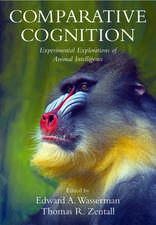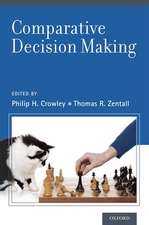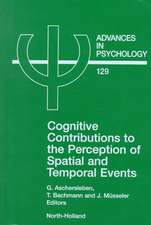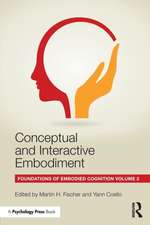Stimulus Class Formation in Humans and Animals: Advances in Psychology, cartea 117
Editat de T.R. Zentall, P.M. Smeetsen Limba Engleză Hardback – 23 oct 1996
Din seria Advances in Psychology
- 18%
 Preț: 949.99 lei
Preț: 949.99 lei - 18%
 Preț: 985.10 lei
Preț: 985.10 lei - 15%
 Preț: 457.33 lei
Preț: 457.33 lei - 23%
 Preț: 683.48 lei
Preț: 683.48 lei - 23%
 Preț: 675.31 lei
Preț: 675.31 lei - 23%
 Preț: 676.64 lei
Preț: 676.64 lei - 5%
 Preț: 839.37 lei
Preț: 839.37 lei - 5%
 Preț: 834.81 lei
Preț: 834.81 lei - 23%
 Preț: 668.19 lei
Preț: 668.19 lei - 34%
 Preț: 317.98 lei
Preț: 317.98 lei - 23%
 Preț: 674.72 lei
Preț: 674.72 lei - 20%
 Preț: 1422.35 lei
Preț: 1422.35 lei - 27%
 Preț: 737.53 lei
Preț: 737.53 lei - 20%
 Preț: 1519.06 lei
Preț: 1519.06 lei - 5%
 Preț: 1542.08 lei
Preț: 1542.08 lei - 27%
 Preț: 1020.01 lei
Preț: 1020.01 lei - 27%
 Preț: 1330.32 lei
Preț: 1330.32 lei - 27%
 Preț: 998.93 lei
Preț: 998.93 lei - 27%
 Preț: 1300.14 lei
Preț: 1300.14 lei - 27%
 Preț: 1299.87 lei
Preț: 1299.87 lei - 27%
 Preț: 1080.20 lei
Preț: 1080.20 lei - 27%
 Preț: 1076.26 lei
Preț: 1076.26 lei - 27%
 Preț: 1075.55 lei
Preț: 1075.55 lei - 27%
 Preț: 1078.09 lei
Preț: 1078.09 lei - 27%
 Preț: 1161.01 lei
Preț: 1161.01 lei - 27%
 Preț: 763.84 lei
Preț: 763.84 lei - 27%
 Preț: 908.62 lei
Preț: 908.62 lei - 27%
 Preț: 862.90 lei
Preț: 862.90 lei - 27%
 Preț: 770.45 lei
Preț: 770.45 lei - 5%
 Preț: 1010.86 lei
Preț: 1010.86 lei - 23%
 Preț: 713.55 lei
Preț: 713.55 lei - 23%
 Preț: 616.28 lei
Preț: 616.28 lei - 20%
 Preț: 691.31 lei
Preț: 691.31 lei - 23%
 Preț: 628.12 lei
Preț: 628.12 lei - 23%
 Preț: 653.33 lei
Preț: 653.33 lei - 27%
 Preț: 1382.65 lei
Preț: 1382.65 lei - 27%
 Preț: 1134.35 lei
Preț: 1134.35 lei - 23%
 Preț: 620.13 lei
Preț: 620.13 lei - 23%
 Preț: 651.55 lei
Preț: 651.55 lei - 23%
 Preț: 627.38 lei
Preț: 627.38 lei - 23%
 Preț: 616.73 lei
Preț: 616.73 lei - 27%
 Preț: 1051.14 lei
Preț: 1051.14 lei - 23%
 Preț: 627.09 lei
Preț: 627.09 lei - 27%
 Preț: 1198.73 lei
Preț: 1198.73 lei - 27%
 Preț: 1109.39 lei
Preț: 1109.39 lei - 27%
 Preț: 969.09 lei
Preț: 969.09 lei - 27%
 Preț: 1107.69 lei
Preț: 1107.69 lei - 5%
 Preț: 837.76 lei
Preț: 837.76 lei - 23%
 Preț: 621.30 lei
Preț: 621.30 lei
Preț: 1127.58 lei
Preț vechi: 1544.63 lei
-27% Nou
Puncte Express: 1691
Preț estimativ în valută:
215.76€ • 225.88$ • 178.53£
215.76€ • 225.88$ • 178.53£
Carte tipărită la comandă
Livrare economică 07-21 aprilie
Preluare comenzi: 021 569.72.76
Specificații
ISBN-13: 9780444824011
ISBN-10: 0444824014
Pagini: 308
Ilustrații: 1
Dimensiuni: 156 x 234 x 19 mm
Greutate: 0.63 kg
Editura: ELSEVIER SCIENCE
Seria Advances in Psychology
ISBN-10: 0444824014
Pagini: 308
Ilustrații: 1
Dimensiuni: 156 x 234 x 19 mm
Greutate: 0.63 kg
Editura: ELSEVIER SCIENCE
Seria Advances in Psychology
Cuprins
Preface. Introduction. On the origins of behavior structure (A.C. Catania). Functional and Equivalence Classes in Animals. An analysis of stimulus class formation in animals (T.R. Zentall). Stimulus generalization and hierarchical structure in categorization by animals (W.A. Roberts). Acquired equivalences and mediated generalization in pigeon's matching-to-sample (P.J. Urcuioli). Categorical class formation by an African grey parrot (Psittacus erithacus) (I.M. Pepperberg). Functional and Equivalence Classes in Humans. Derived stimulus control: Are there differences among procedures and processes (K.J. Saunders et al.). Mediating associations, essentialism, and nonsimilarity-based categorization (S.L. Astley, E.A. Wasserman). Equivalence Classes: Stimulus Control Variables. Stimulus classes and the untrained acquisition of stimulus functions (M.J. Dougher). New procedures for establishing emergent matching performances in children and adults: Implications for stimulus equivalence (D. Barnes et al.). Stimulus equivalence: A class of correlations or a correlation of classes (C. Pilgrim, M. Galizio). Implications of a stimulus control topography analysis for emergent behavior and stimulus classes (W.V. Dube, W.J. McIlvane). Equivalence Classes: Verbal Behavior. Naming and the formation of stimulus classes (R. Stromer, H. MacKay). Controlling factors in conditional discriminations and tests of equivalence (J.C. de Rose). Stimulus classes and stimulus relations: Arbitrary applicable relational responding as an operant (S.C. Hayes et al.). Author Index. Subject Index.


















